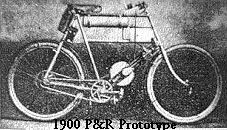The Phelon & Rayner 1.75 hp was a British motorcycle made by Phelon and Rayner (P&R). There was only one P&R model which had a 1.75 h.p., 260 cc. engine with 66 x 76 mm bore and stroke fitted in a standard bicycle type 28" frame (with 23" and 26" options). It was fitted with a surface carburettor, single speed friction disc transmission, a 9 pint combined oil and fuel tank, bicycle pattern front forks and 28 in × 2 in (711 mm × 51 mm) wheels (except for the 23" frame option that had 26" x 1&5/8" wheels). The colour scheme was black frame and mudguards with an aluminium enameled fuel tank with coach lining.[1]
 | |
| Manufacturer | Phelon & Rayner |
|---|---|
| Production | 1901 - 1903 |
| Engine | 260cc |
| Transmission | single speed friction disc |
The prototype was the basis for a patented design.[2] The key innovation was to replace the frame's front down-tube with a four rod frame that held a small de Dion type engine. This 'Sloper' engine was the hallmark of P&M / Panther motorcycles until the last Model 120 more than sixty years later. Production machines of the same design as this prototype were hand-built in 1901 through to 1903.[1]
Development edit
This model was the first motorcycle produced by P&R.[1]
1900 prototype built resulting in design being patented.[2] The key innovation was to replace the frame's front down-tube with a four rod frame that held a small de Dion type engine. This 'Sloper' engine was the hallmark of P&M / Panther motorcycles until the last Panther Model 120 more than sixty years later. Production machines of the same design as this prototype were hand-built in 1901 through to 1903. This prototype machine also featured a further patented innovation:[3] a half compression device to make starting easier. This featured on all future heavyweight P&M / Panther motorcycles.[1]
1901 was the first year of production of the Phelon and Rayner (P&R) 1.75 hp. It had a 1.75 h.p., 260cc. engine with 66 x 76 mm bore and stroke fitted in a standard bicycle type 28" frame (although 26" and 23" became options, presumably due to experience showing 28" was too tall for a motorised bicycle). It was fitted with a surface carburettor, single speed friction disc transmission, a 9 pint combined oil and fuel tank, bicycle pattern front forks and 28 in × 2 in (711 mm × 51 mm) wheels (although smaller wheels were fitted to the smaller frame). The colour scheme was black frame and mudguards with an aluminium enameled fuel tank with coach lining.[1]
1902 was the second year of production of the 1.75 hp. It was fitted with a surface carburettor, single speed friction disc transmission, a 9 pint combined oil and fuel tank, bicycle pattern front forks and 8 in × 2 in (203 mm × 51 mm) wheels (although smaller wheels were fitted to the smaller frame). The colour scheme was black frame and mudguards with an aluminium enameled fuel tank with coach lining.[1] Photographic evidence indicates it was available with (carbide) lights.
1903 was the last year of production of the Phelon & Rayner 1.75 hp.[1] Photographic evidence shows it was used to pull a trailer chair.